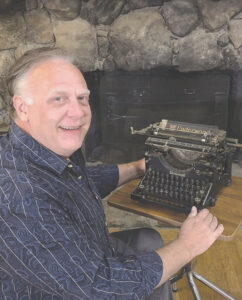The Hope of the Little Lands
Mable gripped the door as the driver made a left turn. The man behind the wheel had introduced himself as Mr. Hartranft and he announced, “This is Michigan Avenue, we’re nearly there.” Mable, her father Frank, and his sister Cora had just left Michigan days before so this was a curious development. Aunt Cora had sent a deposit through the mail to secure an acre and a quarter in the recently founded Little Landers Colony of Los Angeles, and now they were near.
As the vehicle bounced over ruts in the dirt road Mable glanced at her father in the front passenger seat. He was quite different from the other prospective settlers traveling with them. He was nearly 70 then and had been active in both business and politics but, like many of them, he’d suffered losses. Now he was looking for a friendlier climate where he could find peace and make a fine garden.
It was a gorgeous view, Mable thought. A warm, sunny little valley lying between tall mountains on one side and low hills on the other. Compared to the lush landscape of southern Michigan she found it a bit austere but felt it had its own beauty. Mr. Hartranft shouted over the din of the engine, “Sunset Boulevard – just ahead the colony is there.”
Looking from side to side, Mable’s enthusiasm began to wane as she noticed the nearby fields were dominated by nothing but sagebrush and stones of all sizes, strewn far and wide. Her father turned to Mr. Hartranft.
“Sure are a lot of rocks,” he expressed.
After turning right on Sunset Boulevard, Mr. Hartranft raised his right hand and placed his forefinger and thumb against his nose, effectively creating a blinder with his hand. “Don’t pay attention to the rocks, Frank, just look at the views!” he shouted for everyone to hear.
In just moments the car came to a stop, the dust from the road blew over the vehicle and as it cleared a beautiful stone building came into view. A large bell tower rose over a welcoming front door and the group began to head inside. This was the colony clubhouse, they were told, and a large stone fireplace came into view upon entering.
Mable noticed a metal plaque hanging just inside the entrance and made her way over to it. Large letters carefully hammered out at the top of the copper plate read, “The Hope of the Little Lands.”
She read on.
“That individual independence shall be achieved, walking in the sunshine without fear of want. That in response to the loving labor of their hands, the Earth shall answer their prayer. Give us this day our daily bread.”
After a brief presentation by colony founders Mr. M. V. Hartranft and Mr. W. E. Smythe, the three were led the short distance from the clubhouse to the property that Cora had an option to buy. As they approached the lot, they realized this was about the roughest, toughest looking piece of land they had ever seen. Not a single tree provided any shade. The stones were so numerous they could hardly see any ground. It was so barren, and so unlike the rolling green hills of their native Michigan, that Mable began to cry.
The three took some time to think things over but then took possession of the little unfriendly lot. Immediately the work began to clear the stones. Soon the first colony meeting took place in the clubhouse and when they raised the flag, as it fluttered to the top their hopes went with it. The good old Stars and Stripes were familiar and assuring.
Mable Hatch would later admit that these early days in the fall of 1913 were hardly bearable but they made the best of things. They soon came to love the hilly slopes of Tujunga and never regretted becoming Little Landers of Los Angeles.

